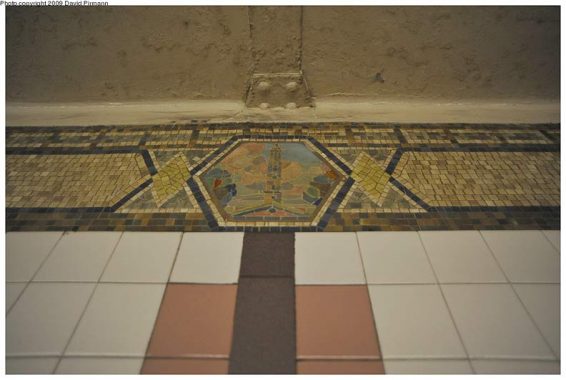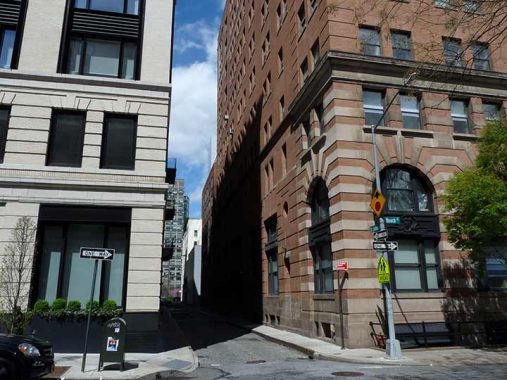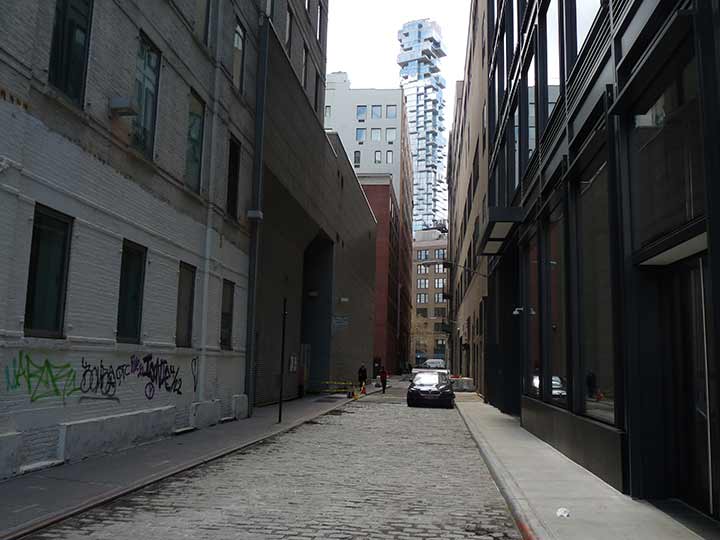
THE ceramic plaque at the Canal Street station on the #1 train, the 7th Avenue line, depicts a church with a towering spire, flanked by ample vegetation. Neither the church that is shown, nor the ample vegetation, is in evidence today. The church is the old St. John’s Chapel, which once stood on the east side of Varick Street between Beach and Laight Streets; the back side of the church faced the alley that was named for it.

By all accounts, St. John’s Chapel was an impressive edifice. The church was completed in 1803 by architect John McComb, and built by his brother, Isaac; McComb would go on to co-create NYC’s City Hall. St. John’s was design was based on that of St. Martin-in-the-Fields in London’s Trafalgar Square, with a portico supported by four Corinthian columns, and a 214-foot high spire. The interior featured freestanding fluted columns, and several years after construction, an ornamental ceiling, and an organ reclaimed from the British, who had captured it during the War of 1812.
St. John’s was constructed at a time when this location was far uptown and Trinity Church was attempting to gain a foothold in the then-wild territory. Trinity was sure to assert its overall dominance by naming St. John’s a ‘chapel,’ not a church. However, the church’s fortunes began to change during the 1860s; even then, this part of what would be called Tribeca by real estate marketers had begun to become dominated by the commercial and manufacturing concerns that would hold sway here until the mid-1990s. Trinity put St. John’s up for sale in 1866 and it was purchased by the very model of a mid-19th Century businessman — Commodore Cornelius Vanderbilt — who razed the verdant grounds and constructed a large freight railroad depot across the street from the church. The church soldiered on, in a deteriorated fashion, until Varick Street was widened as part of the IRT construction beginning in 1913 (that also gave rise to Seventh Avenue South). Today, warehouses and manufacturing concerns occupy the chapel’s old site, and approach ramps to the Holland Tunnel occupy the space of the old depot. The chapel is remembered by the subway mosaic and the once-country lane that ran along its back door.
In As You Pass By, Kenneth Dunshee writes of the area immediately surrounding St. John’s Chapel in the 1830-1860 era: The park and churchyard became noted for the variety and beauty of their trees. The beauty of the homes and the abundance of graceful shade made it a place of imposing grandeur. And the continuous line of balustrades framing the square and the houses and running up the stairs to the doorways added a peculiar aspect of European style and magnificence. Many of the homes had window panes that, in the course of time, acquired a violet tint, similar to those in old houses on Beacon Hill in Boston. The families of Alexander Hamilton, General Schuyler … and others of equal distinction lived in this residential oasis.
An unsuccessful battle to save St. John’s Chapel is described in Max Page’s The Creative Destruction of Manhattan, 1900-1940 and the church is described in Oliver Allen’s Tales of Old Tribeca.

Narrow St. John’s Lane, seen from Beach Street (here) and Laight (title card). At Beach Street the American Thread Company building can be seen on the right.
Like every other street in Manhattan, no matter how narrow, St. John’s Lane has a sidewalk on both sides, and it’s so out of the way that it is still paved with Belgian blocks. The lane is illuminated by finned masts attached to the sides of its facing buildings, as there is no room for lampposts on the narrow sidewalks.
As always, “comment…as you see fit.” I earn a small payment when you click on any ad on the site.
4/18/22


3 comments
Another fascinating post, but could you clarify this: “…constructed a large freight railroad depot across the street from the church, as shown on the map.” Which map?
sorry, deleted the reference.
Here’s some additional info, courtesy of Wikipedia: ”St. John’s Terminal was built by the New York Central Railroad as the southern terminus to the High Line, an elevated segment of the West Side Line on the west side of Manhattan. Prior to the development of the High Line, the West Side Line terminated at a ground-level structure at St. John’s Park.” No doubt Commodore Vanderbilt named his freight terminal after St. John’s Church. The location’s current address is 550 Washington Street, near West Houston Street. Link to full Wikipedia article: https://en.wikipedia.org/wiki/St._John%27s_Terminal